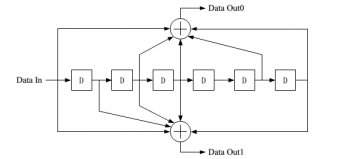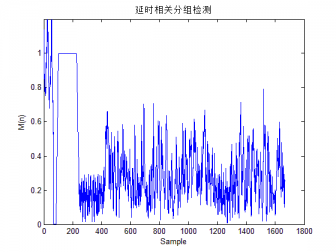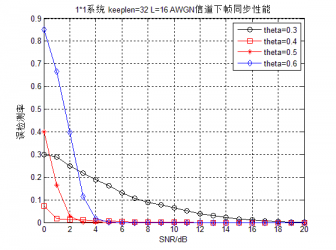论文总字数:28440字
摘 要
随着无线通信技术越来越成熟,无线局域网的研究也成为人们越来越关注的课题。新一代无线局域网协议IEEE 802.11ac随之诞生。它融合了OFDM、MIMO以及MUMIMO多种技术,不仅增加了信道带宽,增加了系统容量,也使传输效率得到了很大的提高。本论文主要针对IEEE 802.11ac物理层协议进行了研究,提出了发射机和接收机的设计方案,并基于LabVIEW软件进行了SISO系统的仿真。论文主要内容如下:
1.对IEEE802.11ac协议规范及其使用的OFDM、MIMO以及MUMIMO等相关技术进行了简介与研究。
2.对IEEE 802.11ac的物理层规范进行了详细的阐述,以及802.11ac发射端采用的关键技术,包括前导码的分段及功能,物理层传输帧格式,并对发射机基带处理流程进行了介绍。
2.对IEEE 802.11ac接收机关键技术进行了研究,进行了定时同步方案的设计以及改进,并对SISO系统的帧同步以及符号同步进行了研究与改进。并对改进后的方案进行了仿真验证,结果显示改进后方案能在保证系统性能的前提下降低无线传输系统实现的复杂度。
4.对IEEE 802.11ac接收机工作流程进行了介绍,对接收机的每个模块的功能及其实现进行了研究,并通过Labview进行了模块仿真。
关键词:IEEE 802.11ac,SISO,发射机,同步,接收机
ABSTRACT
As wireless communication technology is more and more mature, People start to pay close attention to the project WLAN. A new generation of IEEE 802.11 wireless LAN protocols is coming into being. It combines a variety of technologies such as OFDM MIMO MUMIMO. Not only increase the channel bandwidth, increases the system capacity, transmission efficiency has been greatly improved. This paper mainly studies SISO simulation of wireless LAN based on Ni Labview software。Put forward a set of implementation scheme based on the IEEE 802.11ac standard. the key technology of receiving end and transmitter are mainly studied. Paper main contents are as follows:
1. In view of the IEEE802.11 ac protocol specification and its use of OFDM and MIMO and MUMIMO technology has carried on the summary and research.
2. The physical layer specification of the IEEE 802.11ac has been introduced in detail in this paper. As well as the key technology of transmitter under the IEEE802.11ac, including the segment and function of VHT PPDU, the transmission frame format of physical layer. And the transmitter baseband processing are introduced.
3. The key technology of IEEE 802.11ac receiver were studied, the timing synchronization technology has been designed and improved. Also the frame synchronization and symbol synchronization of SISO system is studied and improved. And the scheme has carried on the simulation to be checked. Results show that the improved scheme can reduce the complexity of the wireless transmission system under the premise of guaranteeing the performance of the system.
4. The IEEE 802.11ac receiver working process are introduced, and the function of every module and its implementation in the receiver is studied, finally it has carried on the simulation through the Labview.
Key Words: IEEE 802.11ac,SISO,transmitter,Synchronization,Receiver
目录
摘要 1
ABSTRACT 2
目录 3
缩略语 5
第一章 绪论 7
1.1研究背景 7
1.2 IEEE802.11ac标准 7
1.3 正交频分复用(OFDM)调制技术 8
1.4 MIMO技术 9
1.4.1MU-MIMO 9
1.5 论文内容及其安排 10
第二章 802.11ac物理层简介 11
2.1 802.11ac协议 11
2.2.1.非VHT部分 12
2.2.1.1 L-STF字段 12
2.2.1.2 L-LTF字段 12
2.2.1.3 L-SIG字段 13
2.2.2 VHT部分 13
2.2.2.1 VHT-SIG-A 13
2.2.2.2 VHT-SIG-B 15
2.2.2.3 VHT-STF 16
2.2.2.4 VHT-LTF 17
2.3 DATA字段 17
2.4 发射端原理 18
2.4.1 扰码 18
2.4.2 BCC编码 19
2.4.3 BCC交织 19
2.4.4 调制映射 20
2.4.5 插导频 20
2.4.6 OFDM调制 21
2.5 本章小结 21
第三章 接收端关键技术 22
3.1 定时同步 22
3.1.1 帧同步 22
3.1.1.1 SISO帧同步 22
3.1.2 符号同步 26
3.1.2.1 符号同步偏移影响 27
3.1.2.2 SISO系统符号同步 27
第四章 接收端设计 32
4.1 帧同步过程 32
4.2 帧搜索 33
4.3 符号同步 34
4.4 去CP 35
4.5 FFT 36
4.6 解调与解码 37
4.6.1 解SIGB字段 37
4.6.2 解调 38
4.7 Viterbi译码 39
4.8 解扰 41
4.9 仿真结果 41
4.10 本章小结 42
第五章 总结 43
参考文献 44
致谢 46
缩略语
ADC | Analog-to-Digital Converter |
AGC | Auto Gain Controller |
AMC | Adaptive Modulation and Coding |
AP | Access Point |
AWGN | Additive White Gaussian Noise |
BCC | Binary Convolution Code |
CP | Cyclic Prefix |
CPTR | Common Periodic Time Reference |
CSD | Cyclic Shift Diversity |
DAC | Digital-to-Analog Converter |
DSP | Digital Signal Processor |
FFT | Fast Frequency Transform |
FIFO | First In-First Out |
LDPC | Low Density Parity Check |
L-SIG | non-HT(Legacy) Signal Field |
L-STF | non-HT(Legacy) Short Training Field |
L-LTF | non-HT(Legacy) Long Training Field |
LS | Least Square |
LTF | Long Training Filed |
MCM | Multi-carrier Modulation |
MIMO | Multiple Input Multiple Output |
MMSE | Minimum Mean Square Error |
MU-MIMO | Multiple User Multiple Input Multiple Output |
NI | National Instruments |
OFDM | Orthogonal Frequency Division Multiplexing |
PAPR | Peak-to-Average Power Ratio |
PCI | Peripheral Component Interconnect |
PPDU | PLCP control Data Unit |
RAM | Random Access Memory |
SE | Spatial Expansion |
SISO | Single Input Single Output |
STF | Short Training Filed |
UDP | User Datagram Protocol |
VHT | Very High Throughput |
WLAN | Wireless Local Area Network |
第一章 绪论
1.1研究背景
在现代科技飞速发展的今天,固定的通信模式已不能满足人们生活的需求。从而,无线网络技术被开发出来,它的灵活性,移动性,安装便捷,易于进行网络规划和调整,故障定位容易,易于扩展等特点,使其迅速地成为了人们生活中不可或缺的一部分。束缚人们多年的“牢笼”终于被打破,这将对人类社会的前进带来巨大的影响。IEEE802.11协议的第一个版本在1997年出现,随着技术的不断改进,之后又有802.11b-802.11j等标准被制定。2009年,802.11n标准发布,其核心技术为multiple-input multiple-output(多输入多输出)简称MIMO。这一标准中,物理层传输速率可达600Mbps。而智能天线与波速成型技术的使用,使通信过程中信道的干扰得到了降低,同时也提高了链路的稳定性、移动性,以及覆盖范围。技术的不断改进,也使得801.11标准不断地推陈出新,而新一代的无线网络通信,802.11ac也即将进入我们的生活。
1.2 IEEE802.11ac标准
为了使无线局域网传输速度达到千兆级别,取得质的飞跃。2008年IEEE设立了甚高吞吐率(Very High Throughput)研究组,以此为目标进行研究,研究分为两个项目方案。一个为802.11ac[1],工作频段为5GHz,它继承于802.11n,采用并扩展了802.11n的空中接口(air interface),具有更宽的RF带宽,更多的MIMO空间流,及更高阶的调制。理论上,能够提供1Gbps带宽进行无线局域网通信。另一个是802.11ad,工作频段为60GHz,其传输范围较小,码率较高,适合于家庭设备间的无线传输。802.11ac的核心技术,基于802.11a继续工作在5.0GHz频段上保证向下兼容性,再加上实际频率调制效率的提升,新的传输速度理论上有望达到1Gbps。
基于802.11n,802.11ac的改进:正交频分复用(OFDM),MIMO,多用户多输入多输出(MU-MIMO),以及空时编码等技术的使用,使得传输速率得到了很大的提升;信道带宽的增加,在当前802.11n20MHz的基础上增至40MHz、80MHz,甚至160MHz;802.11ac向后兼容802.11全系列现有和即将发布的所有标准和规范,包括802.11s无线网状架构以及802.11u等。在安全性方面,它将完全遵守802.11i安全标准的所有内容,使得无线连接能够在安全性方面达到企业级用户的需求[2]。
剩余内容已隐藏,请支付后下载全文,论文总字数:28440字
相关图片展示:





该课题毕业论文、开题报告、外文翻译、程序设计、图纸设计等资料可联系客服协助查找;


